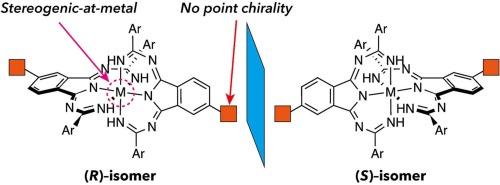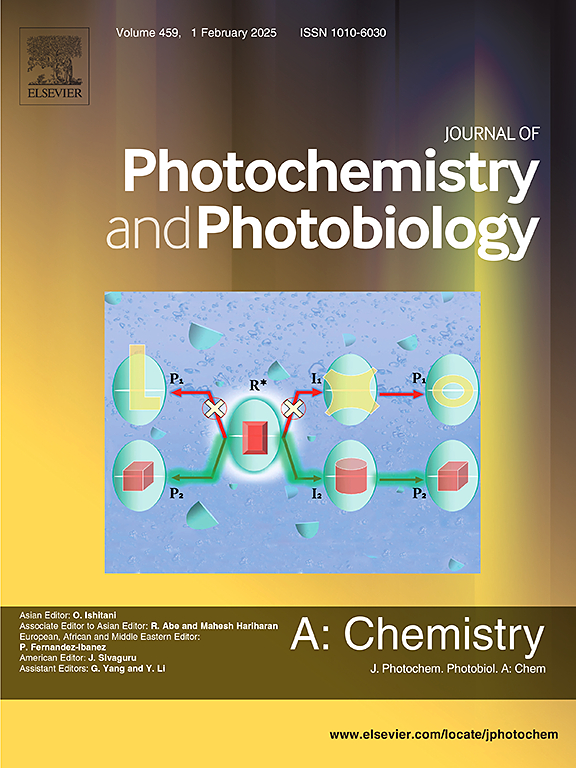诱导近红外吸收球形钌络合物的轴向手性
IF 4.1
3区 化学
Q2 CHEMISTRY, PHYSICAL
Journal of Photochemistry and Photobiology A-chemistry
Pub Date : 2024-10-12
DOI:10.1016/j.jphotochem.2024.116089
引用次数: 0
摘要
在近红外(NIR)区域具有吸收能力的球形金属络合物可以一步合成。虽然已经获得了具有立体性的金属络合物,但轴向手性的诱导尚未得到证实。本研究利用不对称的二亚氨基异吲哚啉衍生物轻松合成了具有轴向手性的近红外吸收球形钌配合物。尽管缺乏离散的点手性分子,但这些配合物显示出分子手性。大块取代基的加入促进了对映体的区分。使用手性色谱柱的高效液相色谱法(HPLC)可以分离出稳定的纯对映体化合物。利用振动圆二色性光谱(VCD)揭示了这些异构体的绝对构型。配体振动产生的特征峰呈现出明显的镜像,理论计算也很好地再现了实验光谱。这种方法对于开发作为近红外材料的手性球形金属配合物具有广泛的适用性。本文章由计算机程序翻译,如有差异,请以英文原文为准。

Induced of axial chirality in near-infrared-absorbing ball-shaped ruthenium complexes
Ball-shaped metal complexes that absorb in the near-infrared (NIR) region can be synthesized in a single step. Although stereogenic-at-metal complexes have been obtained, the induction of axial chirality has not yet been demonstrated. In this study, NIR-absorbing ball-shaped ruthenium complexes with axial chirality were facilely synthesized using asymmetric diiminoisoindoline derivatives. Despite lacking a discrete point chiral moiety, these complexes exhibited molecular chirality. The incorporation of bulky substituents facilitated enantiomeric differentiation. High-performance liquid chromatography (HPLC) with a chiral column enabled the isolation of the pure enantiomers as stable compounds. The absolute configurations of these isomers were revealed using vibrational circular dichroism (VCD) spectroscopy. The characteristic peaks originating from ligand vibrations exhibited distinct mirror images, and the experimental spectra were well reproduced by theoretical calculations. This methodology has broad applicability for the development of chiral ball-shaped metal complexes as NIR materials.
求助全文
通过发布文献求助,成功后即可免费获取论文全文。
去求助
来源期刊
CiteScore
7.90
自引率
7.00%
发文量
580
审稿时长
48 days
期刊介绍:
JPPA publishes the results of fundamental studies on all aspects of chemical phenomena induced by interactions between light and molecules/matter of all kinds.
All systems capable of being described at the molecular or integrated multimolecular level are appropriate for the journal. This includes all molecular chemical species as well as biomolecular, supramolecular, polymer and other macromolecular systems, as well as solid state photochemistry. In addition, the journal publishes studies of semiconductor and other photoactive organic and inorganic materials, photocatalysis (organic, inorganic, supramolecular and superconductor).
The scope includes condensed and gas phase photochemistry, as well as synchrotron radiation chemistry. A broad range of processes and techniques in photochemistry are covered such as light induced energy, electron and proton transfer; nonlinear photochemical behavior; mechanistic investigation of photochemical reactions and identification of the products of photochemical reactions; quantum yield determinations and measurements of rate constants for primary and secondary photochemical processes; steady-state and time-resolved emission, ultrafast spectroscopic methods, single molecule spectroscopy, time resolved X-ray diffraction, luminescence microscopy, and scattering spectroscopy applied to photochemistry. Papers in emerging and applied areas such as luminescent sensors, electroluminescence, solar energy conversion, atmospheric photochemistry, environmental remediation, and related photocatalytic chemistry are also welcome.

 求助内容:
求助内容: 应助结果提醒方式:
应助结果提醒方式:


